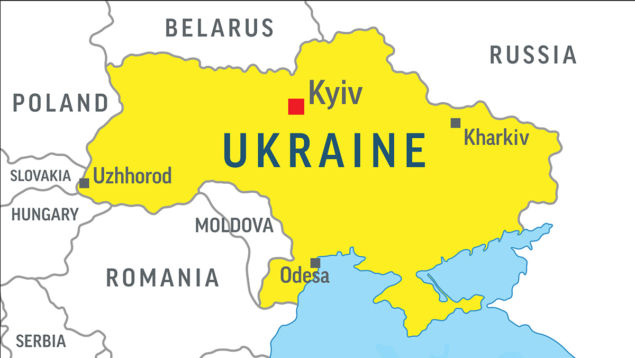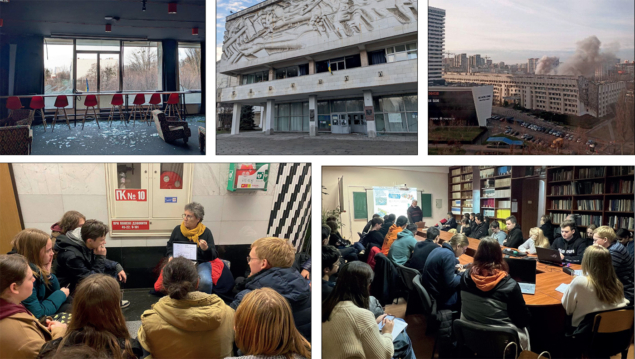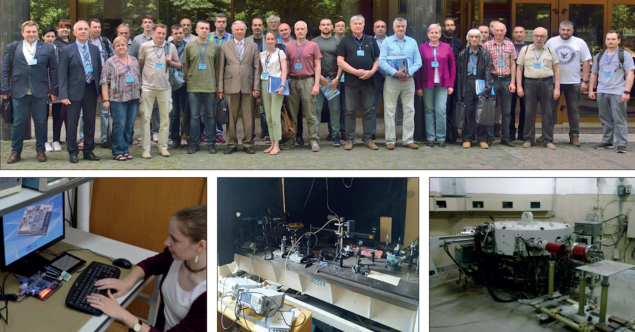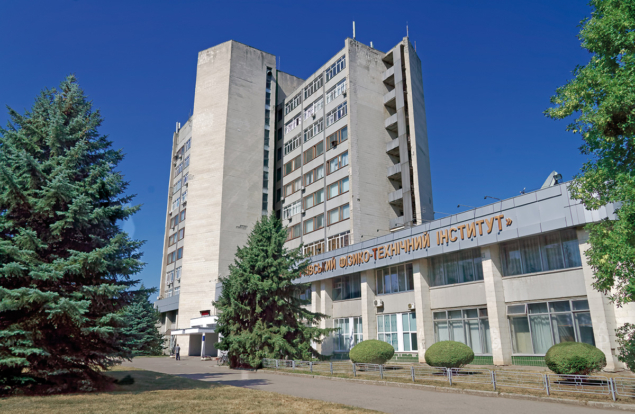Ukrainian physicists have a rich history in fundamental research and Ukraine joined CERN as an associate member state in 2016. Russian scientists also have a long and distinguished involvement with particle physics, and Russia was granted Observer status (currently suspended) in recognition of its contributions to the construction of the LHC. On 24 February 2022 the Russian army launched a full-scale invasion of Ukraine. In the first hours of the war, the majority of scientific organisations in Ukraine found themselves in the war zone, either directly or through missile strikes. In a short period, faced with huge challenges, most laboratories and institutes have recovered and many people are back at work. But the war has taken a terrible toll, especially on the composition of research groups and on young researchers. Here, we collect some of the experiences from physicists in Ukraine about how they and their institutes are recovering from the damage so far, the importance of continued global support, and how science in Ukraine can be rebuilt when the war is over.

Institute for Scintillation Materials, Kharkiv
Located in Kharkiv, the Institute for Scintillation Materials (ISMA) of Ukraine has both a large scientific base and technological facilities for the production of scintillation materials and detectors. It has been a member of the CMS collaboration for about 20 years, including participation in the production of scintillation tiles for the current calorimeter and as a potential manufacturer of tiles for the HGCAL upgrade. Since 2021, ISMA has also been a technical associate member of LHCb hosted by the University of Bologna, where we participate in the PLUME (probe for luminosity measurement) project. ISMA is also a member of the Crystal Clear Collaboration at CERN and, since 2019, of the 3D printed detectors (3DET) project (see p8). In addition, ISMA is a supplier of scintillation materials and detectors for projects outside CERN.

With the outbreak of the war in Ukraine, the Institute became a home for many. In the months following March 2022, about 50 staff members lived in the basement with their families and pets. In addition, some 300 people who were living nearby moved into the Institute’s bomb shelter, where staff provided food and helped people to adapt.
At the beginning of March 2022, one of our processing areas for crystal growth was damaged due to an air raid. This was shocking not only to us, but also for our partners for whom we serve as the main supplier of products. It was necessary to make a quick and important decision: wait until the end of active hostilities and then reconstruct infrastructure and technology, or start doing something now. We realised that technological downtime would result in the loss of a market that had been developed over decades and would also make it economically impossible for us to restart production cycles with the necessary volumes. We got together with our staff, who were living on the Institute’s territory. Some people even came to besieged Kharkiv from other cities to help. Between alarms and artillery shelling, the guys were coming out of the bomb shelters to go to work. Just one month after the war started, products were already being shipped to our customers. Once temperatures started to rise above zero, we started to move the processing equipment and growth units out of the damaged processing area. Not only did we have to repair these, but we also had to clear the premises of other equipment, calculate and pour new foundations, hook up the entire infrastructure and lay the lines for services – all in a period of a few months. By May 2022, we had already started growing large crystals of up to 500 mm in diameter at the new location. Some of our partners did not even notice the delays in delivery and we were able to meet our delivery commitments for 2022 in full.
We are very grateful to our colleagues, and to our friends at CERN, who offered their help and supported us from the early days of the war. They were not only CERN staff members, but also people from other institutes and organisations who called and wrote letters every day. They even organised a special programme to welcome families who had to leave Kharkiv at that time, and helped to persuade those who did not want to leave to move to safer cities in Ukraine or in Europe, at least temporarily.
By mid-summer, ISMA resumed the production of experimental scintillator tiles for CMS
In April 2022 we started discussions on future cooperation with our colleagues at CERN. Unfortunately, it was impossible to continue any work during the first two months of the war. However, we agreed that work should not stop and that some of it could be carried out in the organisations of our partners. We collected all the materials from Kharkiv that our colleagues needed and sent it to them. Some female colleagues, who could leave Ukraine, were also invited temporarily to continue their work abroad in these organisations. This allowed us to continue joint research programmes with our European partners. All our R&D projects were maintained either in Kharkiv or at the partner institutes abroad.
In May 2022 we were informed that ISMA, together with CNRS, Université Claude Bernard Lyon 1 and CERN, had won a project financed from the European Union’s Horizon Europe programme to develop inorganic scintillation crystals for innovative calorimeters for high-energy physics. By mid-summer, ISMA resumed the production of experimental scintillator tiles for CMS. We also continued work on developing technology for the synthesis of scintillation granules based on inorganic crystals. At the end of summer 2022, the crystals had already been shipped to our partners. Work on the 3D printing of scintillators in Kharkiv continued unabated.
Despite the war and its impact on life in Kharkiv and work at our Institute, over the past 18 months ISMA was able to contribute to all of the ongoing projects at CERN, and even expanded its capacity by transferring some work to other European institutes – strengthening our capabilities to do world-class research. The technological aspect of scintillator production has been restored and ISMA is receiving new requests to design and manufacture scintillators for international projects. We are grateful to our partners for their support and cooperation.
Andriy Boyaryntsev deputy director ISMA.
Taras Shevchenko National University of Kyiv
Our group at Kyiv has cooperation with many European universities and groups. We collaborate on LHCb and on the proposed SHiP experiment at CERN, and the International Large Detector – a general-purpose detector for an electron–positron collider, primarily the ILC. The group has many scientific contacts with IJCLab at Paris-Saclay and cooperates with ETH Zurich on the study of perovskite materials. Before the war and COVID periods, our students had many internships in various European institutes and staff travelled regularly to Europe.

In the first weeks of the war, there was a serious disruption to life and to hopes for the future. Many of the women and girls were evacuated from Kyiv to the west of Ukraine and abroad. With the help of our graduates and foreign colleagues, I sent 17 female students to various European cities for long-term internships. Many other teachers also helped some travel to Europe.
At that time, we were really expecting a nuclear strike from a maddened neighbour. Thanks to our colleagues abroad, the registration of internships took place instantly, in just a few days. Meanwhile, the men in Kyiv were preparing for battles on the streets. I actively read how to use various types of weapons, even though I was not accepted due to my age. I was sure that I would find weapons on the streets during the fighting, and I collected equipment and materials for actions after a nuclear explosion (nuclear physics is our department specialty). Now it already looks childish, but at the beginning of March 2022 I said goodbye to my wife, who was evacuated to Europe to join her daughter, because we thought that we would never meet again.
I was not afraid: there were almost only men left in the city, and those who remained were ready to stand to the death. The general feeling of a joint struggle united us and supported our spirit. It was clear in those weeks that this was not the time for science. I did some volunteering, first buying body armour and other military equipment, then collecting money for the purchase of jeeps for the front line and prostheses for crippled soldiers. We (with the alumni of our department in Ukraine and abroad) collected for the army very quickly, raising the necessary several thousand euros in a few days.
Since autumn 2022, we have resumed our scientific work and the connections with students
After the defeat of the Russian forces near Kyiv and Kharkiv, and especially after the return of Kherson, it became a little easier and we began to implement grants for students. This partially compensated for the decrease in real salaries and scholarships, and the high inflation of the hryvnia. Since autumn 2022, we have resumed our scientific work and the connections with students. We also have a lot of volunteer work as physicists and engineers. Many of the women and children have returned home – as has my wife. The main problem now is a more than two-fold drop in wages, taking into account inflation.
On 31 December 2022 a large Russian missile exploded between the buildings of the university. The explosion occurred at a height of several metres (the rocket had impacted a large tree), completely or partially destroying more than 500 large windows in seven buildings, including two thirds of the windows in our building.
Our small group now has acceptable working conditions. Currently, quite a lot of European and partial US grants are provided to our students for remote work. However, the necessary restriction during the war period on trips abroad for boys and men of conscription age has greatly hindered both scientific work and effective teaching. There has been a rapid washout of qualified personnel from scientific groups, especially young people who have been driven to look elsewhere for acceptable wages in Ukraine or abroad. After the end of the war, it will be difficult (or even impossible in some areas) to restore an effective group composition. Obtaining scientific grants during the war can significantly stop this degradation of science in our country.
Ukrainian science has been seriously affected due to the constant bombing of buildings and scientific facilities, the large outflow of personnel (especially women) to institutes and universities abroad, the decrease in real salaries, and the blocking of international internships and scientific travel for male scientists. I am sure that, step by step, we will restore lost contacts with foreign scientific centres and rebuild the scientific and educational resources of Ukraine that have been destroyed by the Russian invasion.
Oleg Bezshyyko associate professor, Taras Shevchenko National University of Kyiv.
Odesa National University
When the war started on 24 February 2022, I was with my family in Odesa. At around 4 a.m. I saw from the window in my flat how Russia had bombed Odesa port. In that moment, it was very difficult to understand what was going on and how to act. Yet, within a week, when it became clear that this was a real war, I received invitations from people in the physics department of the Jagiellonian University in Krakow, Poland, to visit them in the capacity of a visiting professor. I drove with my family through Moldova, Romania, Hungary, Slovakia and finally arrived in Krakow, where the people from the department adopted us. The children went to school the next day. There is only a small difference in language between Polish and Ukrainian, so it was not too difficult for them to adapt. Two months later I received an invitation from a new institute near Dresden called the Сenter for Advanced System Understanding (CASUS), where I have been based ever since.

As a theoretical physicist, and a frequent visitor to the CERN theory department, it’s much easier for me to move than it is for those who are connected to an experiment. Many of the laboratories in Ukraine have been completely destroyed. How they manage is difficult for me to comprehend. Odesa was not occupied, so it was possible to remain there. But in winter there was no electricity or heating, and during the day there were often air alarms when residents had to go to shelters. We were also worried about our grandchildren. A few weeks after the war started, a rocket fell a couple of hundred metres from my apartment.
Prior to the invasion, I would travel to Russia for conferences but I didn’t have any collaborations with Russian institutes. For me to work abroad is quite a normal situation. But I thought it was just my own will. Now I will stay here because of the war. But I also miss Ukraine and Odesa. The question is what will happen when we win? The answer is not so simple.
Without investing money into science it is impossible to build a strong country
Without investing money into science it is impossible to build a strong country. But to have that requires a good level of education, and that’s not easy because many young people are abroad. Will they go back, and how? If we have a good scientific climate, I think many would like to return. But if there is no money for science, then no. The government situation is not easy. The eastern part of the country is completely destroyed. Up to now only a small percent of the nation’s budget goes to science. The level of education and science in Ukraine already went down in the 1990s compared to when it was part of the Soviet Union. Many good scientists went abroad and have not returned.
We are currently living in a state of stress and uncertainty. Our minds are completely occupied by the news. The situation is even worse for those who stay in Ukraine. Many young scientists would like to go to foreign institutions and many foreign universities and institutes have adopted Ukrainian people, especially female scientists. But for boys it is forbidden. The border is closed. How many cross it illegally is probably only a small percentage. They stay mainly inside of Ukraine, often to fight against Russia. I know many people who were killed, including a former astronomy student who was educated at Odesa University.
The second year of the war is ending. A difficult winter is ahead. Russia will again try to destroy infrastructure with missiles and drones, so that people have neither heat nor light, so that they lose the will to win. The situation is very difficult. I don’t know what will happen next year or the year after. I can’t imagine where my family and I will live. I really want to return to Odesa. But for this, Ukraine must win.
Oleksandr Zhuk Odesa National University; currently CASUS Germany.
Uzhhorod National University
Uzhhorod National University was established in 1945, and five years later the faculty of physics and mathematics began its work. Today, the university has cooperation with around 90 institutions worldwide. We have activities in solid-state physics, optics and laser physics, physics of electron–atom collisions and plasma, quantum theory of scattering, and astrophysics and astronomy. For the past five years our group (comprising 10 engineers, technicians, senior scientists and PhD students) has been cooperating with the ISOLDE facility at CERN. At the beginning this was a multidisciplinary project to investigate materials that have spontaneous magnetisation and polarisation. We have published several articles in this area and in particular have proposed layered van-der-Waals crystals – a promising field for applications that can be further investigated with ISOLDE.

Uzhhorod is located just at the western Ukrainian border towards Slovakia and 20 km to the border with Hungary. While there were a few attacks from Russian forces, the situation here is relatively okay compared to other parts of Ukraine. We have the possibility to work, although there were times where we wouldn’t have electricity, so we couldn’t do any measurements or calculations. When the war started I immediately received calls from many colleagues outside Ukraine, who asked me to come to their labs. I did not expect this at all. Generally, many scientists left, especially from Kharkiv. Many of them came to Uzhhorod, others went abroad, for example to Poland, the US, the UK or France. For many who are from highly bombarded regions, this was certainly the correct decision; otherwise, they could have been killed. We keep in touch and continue our work.
After the first week of the invasion, we evaluated the situation and hoped that Kyiv would remain unoccupied. After about a month, we fully resumed work. It took some time to get back to a reality where you can concentrate. Looking back, it felt like a state of hypnosis, because the situation was so bad. Now, it’s better. I have published three papers in Physical Review since the beginning of the war. I hope we continue to receive support from European countries, the US, Canada, Australia and Japan.
Long before the invasion, I often participated in meetings and worked with Russian scientists. After the annexation of Crimea in 2014, I stopped. Many others continued to collaborate after 2014. We are academics after all, and we work in science. Maybe after the war, some peace regulation will make scientific and diplomatic co-operations possible again. To use an analogy from solid-state physics, the 2014 invasion of Crimea was a first-order transition whereas this one was a second-order transition that continues with a modulated phase.
It took some time to get back to a reality where you can concentrate
Since the invasion, we have prepared and submitted a proposal to the European Union Horizon programme. After successful evaluation at the beginning of October, together with scientists from Portugal, Spain, Denmark, Poland and from Kyiv, we have started the Piezo2D project to investigate piezoelectricity in 2D materials and their relevant device performance.
It is crucial to have Ukrainian universities participate in academic European programmes, not just formally on paper but to be actively involved. We don’t ask for any preference. We want to have the same possibilities as any other country to participate and for our people have the experience to be part of it.
As I am over 60 years old, I am allowed to leave the country. But younger male scientists can’t leave unless they have a permit for special services or duties. Some find special permission to study abroad as PhD students. Many others went to join the Ukrainian army. Some of us, especially physicists and chemists, are involved in special technology R&D programmes.
I’m sure that Ukraine will win the war. Then we will rebuild the economy, society and science. The latter will be especially important. Our government understands that science produces knowledge, and now is the time for it. For now, however, we must hope and work with the situation at hand. And here goes a big “thank you” from me and my colleagues to all those helping and supporting us at CERN and beyond.
Yulian Vysochanskii head of the semiconductor physics department, Uzhhorod National University.
Kharkiv Institute of Physics and Technology
Our institute, founded in 1928, has a long connection with high-energy physics and with CERN. Theorists Dmitrij Volkov and Vladimir Akulov played a crucial role in the development of supergravity and supersymmetry, for example, and for more than 20 years researchers at Kharkiv Institute of Physics and Technology (KIPT) have been actively working with the LHC experiments. In CMS, for which we contributed to the endcap hadron calorimeters, we host a Tier-2 computational cluster that is considered one of the best; in LHCb we have participated in the calorimeter system maintenance and support. In collaboration with colleagues at Bogolyubov Institute for Theoretical Physics in Kyiv, we participate in the inner tracking project for ALICE and are working on ITS3 upgrade. We also have collaborations with CERN concerning new theoretical and experimental proposals, for instance on the interaction of half-bare particles with matter. The first electron accelerator with an energy of 2 GeV in Europe was created and launched at KIPT in 1965. Before February 2022, the institute continued to operate a number of electron accelerators of lower energies and several large installations, such as the stellarator and quasi-stationary plasma accelerator.

Prior to the Russian invasion, our institute had a staff of more than 2000 people. In former Soviet Union times it was three times larger, and subordinate to the ministry within which the atomic project was performed (our institute had the status of laboratory no. 1). It was not so well known at the time because we were a closed-regime facility. In 1993 our institute became the first national scientific centre of Ukraine, with the full name National Science Centre “Kharkiv Institute of Physics and Technology” (NSC-KIPT), and our scientists started to cooperate actively with CERN and other international centres. NSC KIPT consists of institutes devoted to theoretical physics, high-energy and nuclear physics, solid-state physics, plasma physics, plasma electronics and new methods of acceleration, in addition to a number of quite large scientific complexes. A significant portion of the institute’s work centres around the Neutron Source facility (which is being created jointly with the US Department of Energy) and R&D into fuels for nuclear power plants. Based on this setup we are promoting the creation of an international centre for nuclear physics and medicine, a preliminary proposal for which has been supported by the US and the IAEA. COVID, followed by the full-scale invasion of the Russian army, have temporarily put this project on hold.
The institute has sharply increased cooperation with major international scientific centres
At the beginning of the invasion, an idea was spread quickly by Russian media that our institute was still working on the creation of nuclear weapons. It was a lie. Similar things were also said by the Russian media, incorrectly, to be taking place at Chernobyl. On 6 March 2022 we got together with the head of the institute of safety operations for nuclear power plants in Kyiv and made a joint declaration rejecting these accusations. Since 1994, and especially lately (even during the war), the institute has been regularly inspected by the IAEA. Of course, no violations were discovered, nor was any work on the creation of nuclear weapons discovered.
Our institute is located around 30 km from the border of Russia. Since 24 February 2022, it has been repeatedly shelled and has suffered significant damage. More than 100 shells, rockets and bombs fell on its territory. At the very beginning, Russian troops started their movement to Kharkiv along the road near our institute; it was stopped by our soldiers. About one month later, Russia made a second attempt to take Kharkiv, which came within 500 m of our institute before being stopped. Outside the institute in a residential area called Piatykhatky, where many staff members live, multiple buildings were destroyed. For 40 days following the shelling of 31 March 2022, the entire area didn’t have water, electricity or phone networks. Thanks to the hard work of the staff who remained, we managed to restore everything, often while bombs were falling.
With the start of military activity, many specialists from the institute left Kharkiv and continued to work remotely. Some large installations intended for conducting physical experiments have remained operational. The institute has sharply increased cooperation with major international scientific centres such as CERN, DESY, Orsay, the Italian centres at Frascati and Ferrara, and others.
With great hope, enthusiasm and optimism we believe that it will be possible to defend the territorial integrity of Ukraine and look to reviving its economic and scientific potential.
Mykola Shulga director-general National Science Centre Kharkiv Institute of Physics and Technology.





